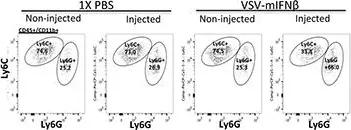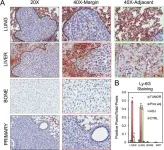The triggering receptor expressed on myeloid cells 2 (TREM2) arginine-47-histidine (R47H) mutation is a significant risk for Alzheimer's disease (AD) with unclear mechanisms. Previous studies focused on microglial amyloid-β (Aβ) phagocytosis with less attention on the impact of TREM2R47H mutation on blood monocytes.
Bone marrow transplantation (BMT) models were used to assess the contribution of blood monocytes carrying TREM2R47H mutation to AD.
Aβ phagocytosis was compromised in mouse monocytes carrying the TREM2R47H mutation. Transplantation of bone marrow cells (BMCs) carrying TREM2R47H mutation increased cerebral Aβ burden and aggravated AD-type pathologies. Moreover, the replacement of TREM2R47H-BMCs restored monocytic Aβ phagocytosis, lowered Aβ levels in the blood and brain, and improved cognitive function.
Our study reveals that blood monocytes carrying the TREM2R47H mutation substantially contribute to the pathogenesis of AD, and correcting the TREM2R47H mutation in BMCs would be a potential therapeutic approach for those carrying this mutation.
TREM2R47H mutation compromises the Aβ phagocytosis of blood monocytes. Blood monocytes carrying TREM2R47H mutation contribute substantially to AD pathogenesis. Correction of the TREM2R47H mutation in bone marrow cells ameliorates AD pathologies and cognitive impairments.
© 2025 The Author(s). Alzheimer's & Dementia published by Wiley Periodicals LLC on behalf of Alzheimer's Association.
Product Citations: 74
In Alzheimer's Dementia : the Journal of the Alzheimer's Association on 1 February 2025 by Yu, Z. Y., Liu, J., et al.
-
Cardiovascular biology
-
Neuroscience
In Cell Reports on 24 December 2024 by Ma, R., Prigge, A. D., et al.
Forkhead box P3 (Foxp3)+ regulatory T cells (Tregs) resolve acute inflammation and repair the injured lung after viral pneumonia. Vimentin is a critical protein in the distal pole complex (DPC) of Tregs. This study reveals the inhibitory effect of vimentin on the suppressive and reparative capacity of Tregs. Treg-specific deletion of vimentin increases Helios+interleukin-18 receptor (IL-18R)+ Tregs, suppresses inflammatory immune cells, and enhances tissue repair, protecting Vimfl/flFoxp3YFP-cre mice from influenza-induced lung injury and mortality. Mechanistically, vimentin suppresses the induction of amphiregulin, an epidermal growth factor receptor (EGFR) ligand necessary for tissue repair, by sequestering IL-18R to the DPC and restricting receptor-ligand interactions. We propose that vimentin in the DPC of Tregs functions as a molecular switch, which could be targeted to regulate the immune response and enhance tissue repair in patients with severe viral pneumonia.
Copyright © 2024 The Author(s). Published by Elsevier Inc. All rights reserved.
-
Immunology and Microbiology
In Molecular Therapy. Oncology on 21 March 2024 by Vienne, M., Lopez, C., et al.
Pancreatic cancer will soon become the second cause of death by cancer in Western countries. The main barrier to increase the survival of patients with this disease requires the development of novel and efficient therapeutic strategies that better consider tumor biology. In this context, oncolytic viruses emerge as promising therapeutics. Among them, the fibrotropic minute virus of mice prototype (MVMp) preferentially infects migrating and undifferentiated cells that highly resemble poorly differentiated, basal-like pancreatic tumors showing the worst clinical outcome. We report here that MVMp specifically infects, replicates in, and kills pancreatic cancer cells from murine and human origin with a mesenchymal, basal-like profile, while sparing cancer cells with an epithelial phenotype. Remarkably, MVMp infection, at a dose that does not provoke tumor growth inhibition in athymic mice, shows significant antitumoral effect in immune-competent models; extended mouse survival; and promoted the massive infiltration of tumors by innate, myeloid, and cytotoxic T cells that exhibit a less terminally exhausted phenotype. Collectively, we demonstrate herein for the first time that MVMp is specific and oncolytic for pancreatic tumors with mesenchymal, basal-like profile, paving the way for precision-medicine opportunities for the management of the most aggressive and lethal form of this disease.
© 2024 The Author(s).
-
Mus musculus (House mouse)
-
Cancer Research
-
Immunology and Microbiology
In Infection and Immunity on 13 February 2024 by Lahiri, P., Arrazuria, R., et al.
Digital dermatitis (DD) is a skin disease in cattle characterized by painful inflammatory ulcerative lesions in the feet, mostly associated with local colonization by Treponema spp., including Treponema phagedenis. The reason why most DD lesions remain actively inflamed and progress to chronic conditions despite antibiotic treatment remains unknown. Herein, we show an abundant infiltration of proinflammatory (CD14highCD16low) monocytes/macrophages in active DD lesions, a skin response that was not mitigated by topical treatment with oxytetracycline. The associated bacterium, T. phagedenis, isolated from DD lesions in cattle, when injected subcutaneously into mice, induced abscesses with a local recruitment of Ly6G+ neutrophils and proinflammatory (Ly6ChighCCR2+) monocytes/macrophages, which appeared at infection onset (4 days post challenge) and persisted for at least 7 days post challenge. When exploring the ability of macrophages to regulate inflammation, we showed that bovine blood-derived macrophages challenged with live T. phagedenis or its structural components secreted IL-1β via a mechanism dependent on the NLRP3 inflammasome. This study shows that proinflammatory characteristics of monocytes/macrophages and neutrophils dominate active non-healing ulcerative lesions in active DD, thus likely impeding wound healing after antibiotic treatment.
-
Mus musculus (House mouse)
-
Immunology and Microbiology
-
Veterinary Research
In Nature Communications on 3 February 2024 by Mercado-Evans, V., Mejia, M. E., et al.
Group B Streptococcus (GBS) is a pervasive perinatal pathogen, yet factors driving GBS dissemination in utero are poorly defined. Gestational diabetes mellitus (GDM), a complication marked by dysregulated immunity and maternal microbial dysbiosis, increases risk for GBS perinatal disease. Using a murine GDM model of GBS colonization and perinatal transmission, we find that GDM mice display greater GBS in utero dissemination and subsequently worse neonatal outcomes. Dual-RNA sequencing reveals differential GBS adaptation to the GDM reproductive tract, including a putative glycosyltransferase (yfhO), and altered host responses. GDM immune disruptions include reduced uterine natural killer cell activation, impaired recruitment to placentae, and altered maternofetal cytokines. Lastly, we observe distinct vaginal microbial taxa associated with GDM status and GBS invasive disease status. Here, we show a model of GBS dissemination in GDM hosts that recapitulates several clinical aspects and identifies multiple host and bacterial drivers of GBS perinatal disease.
© 2024. The Author(s).
-
Mus musculus (House mouse)
-
Immunology and Microbiology
In Oncotarget on 20 October 2015 by Patel, M. R., Jacobson, B. A., et al.
Fig.6.G

-
FC/FACS
-
Homo sapiens (Human)
Collected and cropped from Oncotarget by CiteAb, provided under a CC-BY license
Image 1 of 2
In Breast Cancer Res on 27 March 2015 by Tabariès, S., Ouellet, V., et al.
Fig.4.A

-
IHC
-
Mus musculus (House mouse)
Collected and cropped from Breast Cancer Res by CiteAb, provided under a CC-BY license
Image 1 of 2

